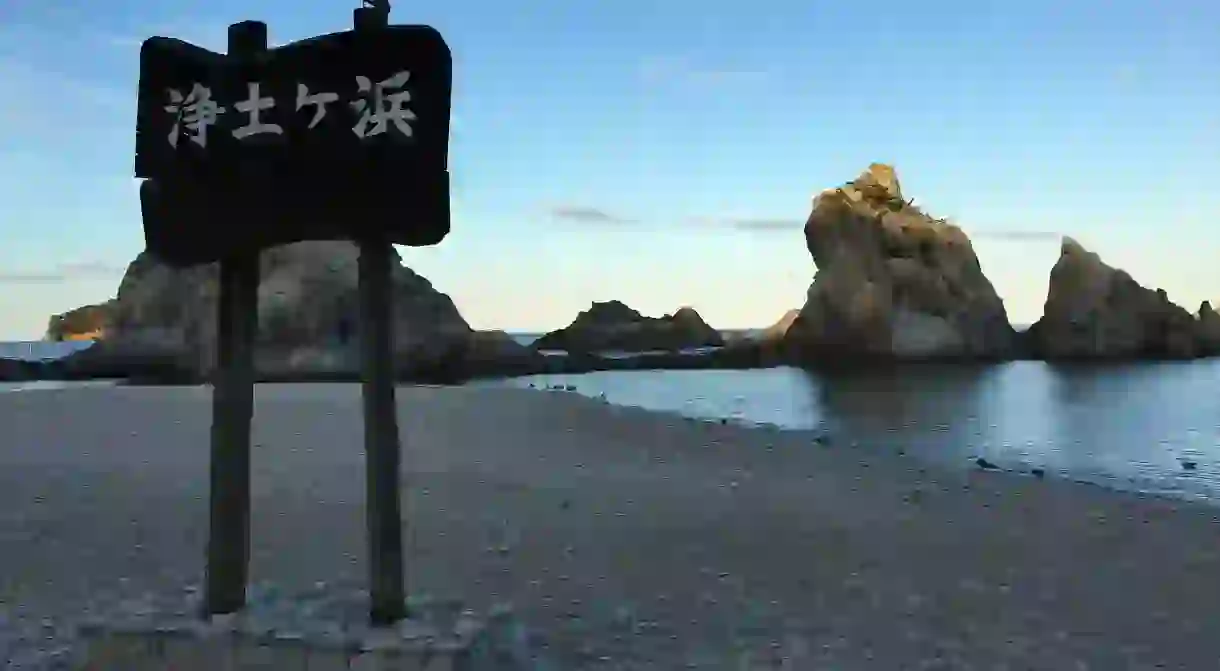Incredible Things To Do in Iwate Prefecture

Located in the country’s Tohoku region in the north of Honshu, Iwate boasts incredible coastlines and mountain ranges, fantastic natural hot springs and some of the country’s best cuisine. With an extensive train network that makes hopping from place to place incredibly easy, there’s a variety of experiences and adventures to be had in the sparsely populated prefecture, all of which embody Japan’s history and tradition.
Geibikei
Named ‘lion’s nose’ after the shape the limestone takes at this spot, this beautiful secluded gorge is surrounded by 50-metre (164-foot) cliff faces on either side of the Satetsu River.
Book a 90-minute boat ride that takes you past waterfalls and limestone caves. At the river’s end you can purchase a small undama (‘luck stone’) and try to throw it into a hole across the gorge – make it and your wish will come true. On the way back down the river, ask nicely and your boatman will even sing a local folk song as he steers you home.

Slurp up soba
Wanko soba noodles are a regional speciality in Iwate and there’s one particular place where you’re encouraged to eat as many as possible: Azumaya Soba. You sit at a table, next to a bucket into which you throw away your broth as you go, and tiny servings of noodles are handed to you repeatedly as you try to hoover them up as quickly as you can. Your bowls are stacked next to you and counted at the end; incredibly, it’s not uncommon for people to put away more than 100. If at any point you want to stop being served, simply place a lid on your bowl, but be warned: if the server lifts your lid and sees any remains, they’ll immediately fill your bowl again.
Watch a rugby game
While sumo and baseball are big in Japan, this region is definitely rugby country, with the town of Kamaishi set to become the smallest town to ever host a Rugby World Cup game during the 2019 tournament, less than a decade after being hit by the devastating 2011 tsunami. A new stadium – the Recovery Memorial Stadium – has been built for the tournament, while the local team, the Kamaishi Seawaves, were instrumental in bringing the World Cup to the Tohoku region.

Unwind in an onsen
While natural hot springs occur in various locations around the world, few can match Japan’s onsens for historic tradition. Some specialise in toji (balneotherapy), the treatment of disease and ailments through bathing in mineral springs; it’s what samurai used to do to heal their wounds after battle. Different onsens have different mineral make-ups.
Nestled in the stunning Hanamaki Onsenkyo village is the Osawa Onsen, a 200-year-old family-run ryokan where you can unwind and learn more about this Japanese practice. Visitors should note that no bathing suits are allowed to be worn in the onsens.
Go fishing
Seafood lovers should head out onto the water that surrounds Holland Island, which is named after the Dutch ship that arrived in Yamada Bay after a storm in 1643. Local fishermen will take you out on their boats to the island via a couple of stops along the way, where they’ll pull out freshly harvested oysters and scallops. After shucking and a little cleaning, they’re ready to be sampled – as fresh, sweet and delicious as anything you’ll ever eat.

Make miso
Miso is the staple of Japanese cuisine – it’s used in sake, soup, broths and plenty else – so making your own at one of Kojiya Motomiya’s classes is a must. Casting his expert eye over proceedings, Motomiya guides you through the reassuringly straightforward process to ensure you end up with some prime paste.
Consisting simply of steamed soy beans, water, salt and koji (the agent that creates the essential fermentation process), the miso is made by mashing everything up by hand. The only thing you get to choose is the amount of salt to add, for either a sweet or strong taste depending on how much you use. At the end of the day, you’ll be able to take home 4kg of one-of-a-kind miso.
Hike
The Michinoku coastal trail spans 700 km (435 miles) of Honshu’s northeastern coastline and is another part of the region that was reshaped after the tsunami. This beautiful trail passes by caves, beaches, mountains and forest, as well as the local ‘Ocean Alps’. The vast majority of it can be done in trainers or walking shoes, but those looking for more of a challenge can head to Mount Hachimantai. With its jade-green lake, stunning views and various lodging facilities near the mountain’s base, it’s the perfect starting point for your adventure.














